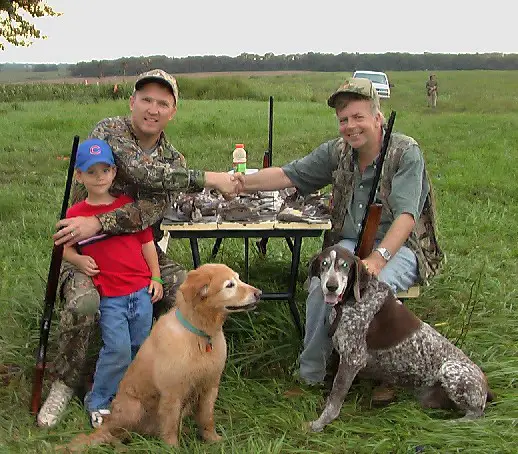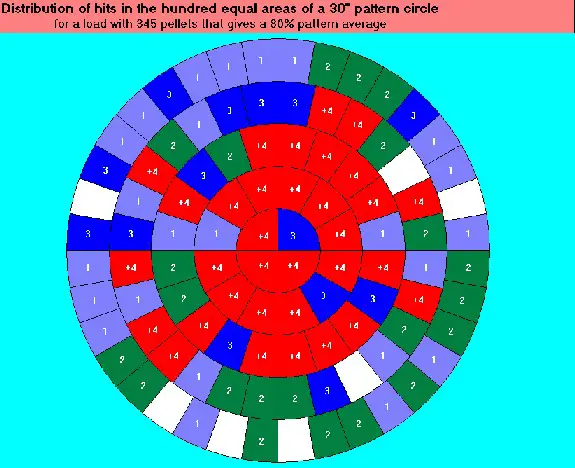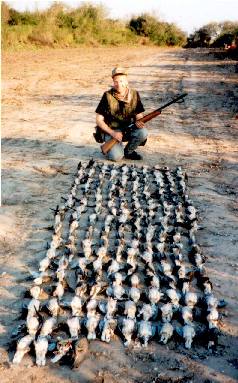


2006 Dove Opener

From the left: My nephew Jack, brother Keith, and myself. In the front: Kelsey the golden retriever and Rocky the German Short-haired pointer. In the center to the back, a pile of decidedly deceased doves.
You can't put too much emphasis on patterning your shotgun: the designation on a factory choke tube is meaningless. It in no way can possibly tell you what your pattern percentage is at any range, much less with a specific shell, a specific shot size, a specific payload, in your specific gun. Since patterns are all we use to impress game birds with, there is no substitute for patterning our own shotguns-- there never will be.
Dropping doves with complete confidence past 50 yards out (and another 15 - 20 yards up) is easy enough-- but only if we do our homework. The goal is an 80% pattern at 40 yards, based on 1 oz. of #7-1/2 shot:

Naturally, doves are not at all difficult to kill-- but they are mostly feathers, and the trick is to get a pellet where it counts. A dove's kill zone is also tiny, so a relatively dense pattern is a must if we want them spinning past 50 yards. A thirty inch circle may not sound like a lot of real estate, but that is a touch over 706 square inches: the Ponderosa compared to the kill zone of a dove.
I use 7-1/2 shot (#7 if reloading) as #8 or smaller has poor time of flight comparatively. Nothing less than 1 ounce loads have done well for me-- it takes a reasonable pellet count to properly populate a pattern at range. Suffice it to say that the 'promo' loads (with the birdies and duckies on the box) are inadequate for reliable drops at long range. We need hard, round shot-- and a goodly quantity of it. It makes all the difference in the world-- the difference between a crippled / lost bird and one that folds up and plummets.
In this case, it was George Trulock to the rescue. I found what I needed for my two primary dove guns: a Browning B-80 20 ga. and a Browning A-5 Sweet Sixteen, both that originally came supplied with standard "Invector" screw chokes that proved horribly insufficient.
You can't buy a better choke tube than a "Trulock Precision Hunter" choke tube. You can spend more, you can get chokes close, but nothing I've tested yet performs better than Precision Hunter tubes-- but only if you use a quality shell, and pattern to find what works best at the range you intend to bag birds at. Chokes are performance-based, not "constriction-based," and you won't know the actual constriction anyway unless you mic your barrel's inside diameter.
We all need to pattern for an individual gun and shell, but for the record: a "modified" Trulock Precision Hunter did the trick for me with the Browning B-80 20 gauge, and it took an "improved modified" Trulock Precision Hunter tube to get me where I needed to be for my Browning Sweet Sixteen. Both of these chokes gave me far better than 70% percentage that is called "Full Choke" in the industry, and gave far better pattern densities than the factory Invector "Full" choke tubes. Forget the markings on factory choke tubes-- worse than inaccurate, they are misleading.
When you score a nice double on doves at 60 yards, invariably you'll hear "Nice shot, unbelievable!" Well, that's not the real story at all-- it is a gun that fits, a quality shell, adequate shot size and payload, and a quality choke selected by patterning with the exact shell you are going to hunt with, that's all.

Copyright 2011 by Randy Wakeman. All Rights Reserved.

Custom Search




